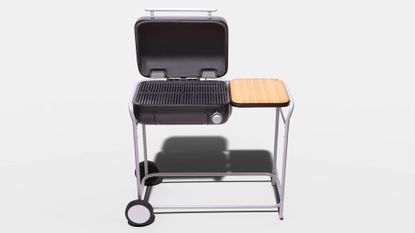Let’s be honest here: charcoal grills can be a pain. You have to clean them out, fill them, light them, then wait for the charcoal to burn down to a nice heat. Couldn’t it be easier? That’s what the Spark Grill does: it brings charcoal grilling to almost the same level of speed and convenience as a propane grill, but still offers the better flavor and cooking flexibility of charcoal. That’s a solution that should pit it against some of the best barbeque grills – both charcoal and gas.
The secret sauce here is the Briq, a custom-made charcoal block that fits into the Spark Grill. These pre-packaged blocks are soaked in alcohol, so they light and burn quickly, creating a nice charcoal fire in a few minutes. And it works pretty well. Within about 10 minutes of inserting a Briq, I was able to start grilling, which is almost as quick as a propane grill. It is very controllable too. You can set the heat anywhere from 250°F for a long, slow cook to a toasty 900°F for searing steaks or quickly cooking pizza, depending on which Briq you use. But it is expensive: at nearly eleven hundred bucks for the base package, you’ll need to be a pretty dedicated charcoal griller to justify the price of this high-end grill. You will also need a nearby power socket, as this grill requires power to run the fans that control the temperature.

SPARK GRILL REVIEW: PRICE AND AVAILABILITY
The Spark grill is available now and costs $1099 for the essentials package, which includes the grill, 3 Briqs, the cutting board, and temperature probes. The $1399 chef’s package that I tested adds five more Briqs, the pizza pack, an apron, and a cover that fits over the grill. Additional Briqs cost $39.99 for a pack of nine quick Bricks or five high-heat ones, or $49.99 for a pack of ten of the low-and-slow Briqs, which use two Briqs for each cooking session.
This is only available in the US at this time – and only in the 48 contiguous states, at that.

SPARK GRILL REVIEW: UNBOXING AND ASSEMBLY
The spark grill is a rather large unit that comes in several boxes and has to be assembled. Like most grills, this is best done with two people, as it is big, heavy, and rather awkward. With four pairs of hands, it is a fairly simple process: you assemble the frame with a few screws (a nice swappable head screwdriver is included), attach the two wheels then put the kettle on the top of this frame. That’s the only difficult part, as the kettle is very heavy, and you have to lift it straight into place, as there are fragile parts on the base of the kettle that could be damaged if you put it down on the ground. It comes with a strap system attached that makes it a little easier, but it still involves lifting a very large and heavy object.
The straps caused the only real problem I had when assembling the Spark grill. After you have put the kettle in place, you then have to remove the straps, which involves lifting up one side of the kettle, pulling the strap out, then repeating this on the other side. Because the kettle weighs about 77lbs (and is not yet secured in place), it nearly tipped over and out of the frame while doing so. Again, this is why you really need two people: one to lift the kettle and hold it in place, and one to pull the straps out. You really don’t want to let this tip out, especially if your foot is in the way.
Finally, you screw in the clips that hold the kettle and put the tray and cutting board in place. Remove the last of the plastic wrap, put the grate and tray in place and you are ready to go. Once you connect the temperature sensors, plug the grill into a wall socket using the included 15-foot cable, download the app (available for Android and iOS) and connect to the grill over Bluetooth. Yup, there is an app for your grill.
Actually, the last stop is to fire the grill up with the included conditioning Briq, oil the grates, and fire up the grill to make sure everything is nicely coated with the smoky goodness that gives charcoal grilling its flavor. To light the block, you simply turn the dial to the ignition position and an electric lighter sets the alcohol-soaked charcoal aflame. Within a few seconds, smoke starts coming out of the grill and the Briq settles into a nice charcoal blaze in a few minutes.
Now you are ready to start cooking.
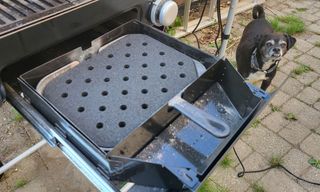
SPARK GRILL REVIEW: OPERATION AND PERFORMANCE
The Spark grill is pretty simple to get going. Each Briq comes in an airtight package that you keep sealed until you want to use them, as they are soaked in alcohol to get the fire going. When you are ready, you open the package, put the Briq into the slide-out tray on the front of the kettle, then turn the dial to start. The igniter inside the kettle sets the alcohol in the Briq alight, which sets the Charcoal alight. Set the temperature dial, close the lid and leave it for 10 minutes or so and the grill will be hot and ready to go. The grill controls the temperature with fans that push air through the Briq. The more air that is pushed through, the hotter the charcoal burns and the hotter the grill. This also makes sure that the Briq is burning nicely, which is much quicker than the 30 minutes or so for starting a standard charcoal grill, and the process is a lot less smoky and unpleasant – you never have to touch a single charcoal briquette.
Spark offers four different Briqs for different types of grilling: a low and slow Briq for slow cooking meats, a quick Briq for general grilling of veggies and meat, an everyday brick that burns slightly hotter than the quick one, and a high-heat Briq for pizza and flatbreads. That’s a much wider range of temperatures than most grills, which usually can’t get beyond 500 degrees.
This higher temperature means it is also great for pizza, and Spark Grills offers a $150 Pizza pack that includes a pizza stone and a peel to place and remove the pizza. The stone replaces the standard grates, providing a very hot surface that cooks a pizza quickly and evenly. Running at a toasty 850 degrees, I got excellent results out of this. Cooking a Neapolitan-style pizza only took about three minutes and produced a very crispy, just slightly burnt crust with just melted cheese on the top.
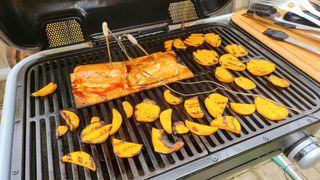
For more general cooking, I found that the Spark offered excellent temperature control and even, well-distributed heat. I was able to, for instance, cook two salmon steaks on cedar planks at the same time as making grilled sweet potato chips, and the chips were evenly cooked over the entire surface of the grates. The large cooking area also means that vegetarians like me can cook alongside carnivores like my wife without getting in each other's way.
There are a couple of things missing that are usually present on propane grills, though, such as a second level to warm food or cook food at a lower temperature. You also can’t have two different temperatures on the grate: even the cheapest gas grills offer a way to run part of the grill at a lower temperature, but not this expensive one.
On the right side of the grate and grill cover is a large prep table, and Spark Grills offers an optional cutting board sized to fit in this space. That surface is nice and large and sits slightly recessed from the metal frame, so things aren’t likely to roll off and into your dog's open mouth. One thing to note here is that Spark Grills recommends that you not use the cutting board at higher temperatures because the whole grill gets pretty darn warm.
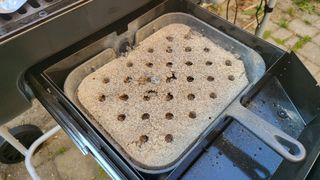
Each Briq lasts about 30 to 45 minutes, depending on the temperature you set. That’s comparable to most charcoal grills that typically provide an hour or so of cooking time. Like most charcoal grills, that can be a bit of a pain. When I used the pizza kit to make a couple of pizzas and flatbreads, I turned the grill off and left it. However, the charcoal was still burning several hours later, and the grill was still very hot long after a propane grill would have cooled. The charcoal Briqs can’t be extinguished while still in the grill, so the whole grill has to be left uncovered somewhere safe until the Briq is completely burnt away. You’ll have the same problem with any charcoal grill, though, but the Spark is less obvious about this.
The exception to this cooking time is the low and slow Briq, which includes two Briqs: one to start the process and a second that burns at a lower temperature for between six and eight hours to slow cook meat. You can add the traditional wood-smoke flavor by putting a few hickory wood chips under the grill grate, where they will slowly be burned and release their magic smoke. That is perfect for slow-cooking meat like pork for a tender, falls-off-the-bone texture. I tested it by slow-cooking a chicken and some veggies for excellent results: the chicken was very well cooked and had a distinct woodsmoke flavor to it.
The Spark Grill works with a free app (available for Android and iOS) that monitors the temperature of the grill and of the optional temperature probes. You can’t control the grill directly with this, but you can set it to alert you when the grill or the probe reaches the desired temperature or set a timer for cooking.
When you are finished cooking and everything is cooled down, you can take out the charcoal tray and throw the ash onto your compost heap. It is fully compostable as the only additive is the alcohol which has burned away.

SPARK GRILL REVIEW: VERDICT
The Spark Grill pretty much delivers on its promise: the flavor of charcoal cooking with propane convenience. It starts much quicker than a standard charcoal grill and is cleaner. You don't have to touch the charcoal or deal with the hassle of laying it out and adding starter material, you just slide in the custom Briq, turn the dial and wait a few minutes.
You are paying a lot for this convenience, though. The grill itself will cost you at least $1100, and you have to buy the Briqs from Spark Grills – you can’t use standard charcoal chunks or briquettes. All of these things mean that it is a serious commitment, both in terms of money, time and preparation. But for the well-heeled charcoal fanatic who wants to avoid some of the hassles of cheaper charcoal grills, it’s a great pick.
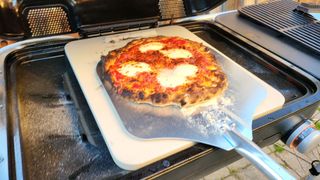
SPARK GRILL REVIEW: Also consider
While there’s nothing that’s quite like the Spark Grill out there, you can find some alternatives. For similar money, you can pick up the Weber SmokeFire EX4, an impressive pellet grill with digital temperature control. Or if you prefer gas, the Weber Genesis E-335 – which features three burners and a sear station – is also just over $1000.
If it’s charcoal you’re after though, you can save a ton of money by investing in Weber’s original kettle grill, which will still leave you enough to buy the coal and the meat from $300.
